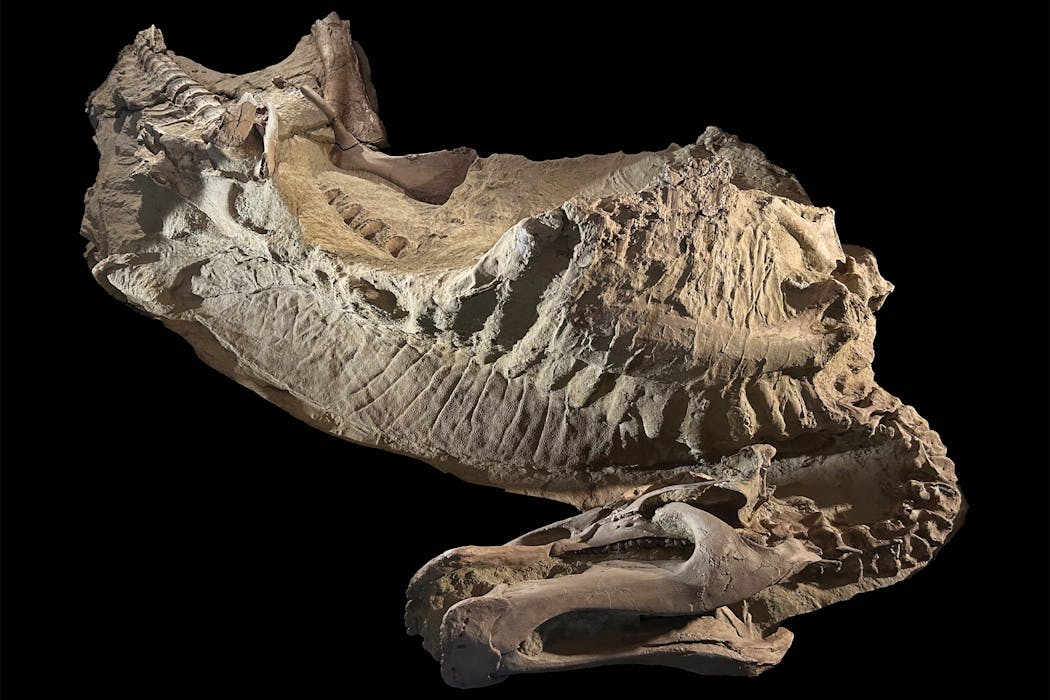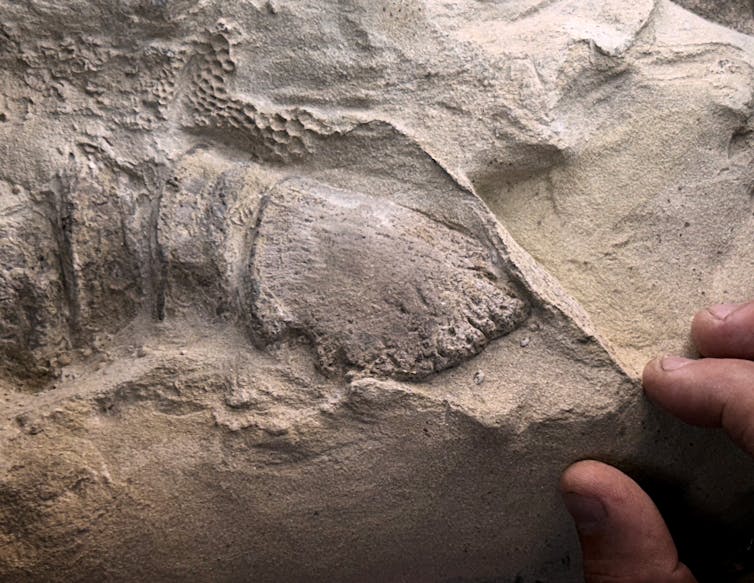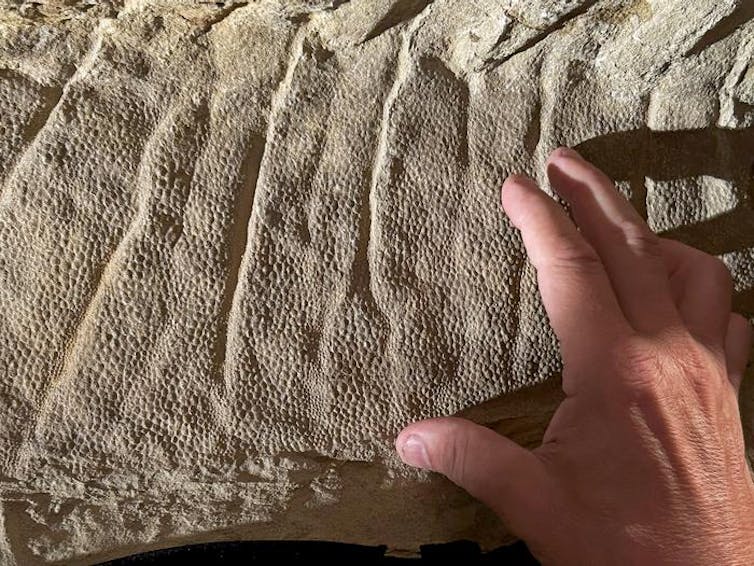Dinosaur ‘mummies’ help scientists visualize the fleshy details of these ancient animals
A clay layer one-hundredth of an inch thick preserves the fleshy details of dinosaurs buried suddenly in east-central Wyoming.

Dinosaur “mummies” couldn’t have been further from my mind as I trudged up a grassy knoll on the Zerbst Ranch in east-central Wyoming, followed by University of Chicago undergraduates on a field trip linked to my “Dinosaur Science” course.
As a university professor, I realized early that to understand paleontology, students would need to see first-hand where fossils are born. And that field experience had to be real, a place I wanted to be – somewhere where we had a shot at discovery.
I chose outcrops of the Lance Formation, a rock formation composed largely of sandstones laid down during last few million years of the dinosaur era. These rocks are well exposed in the parched badlands of Wyoming, crisscrossed for more than a century by dinosaur hunters. Yet, perhaps they missed something.
Then I saw it.
At the top of the hill lay a massive concretion – a hardened, iron-stained rock the size of a compact car – surrounded by some fossil bone fragments. Poking from its side were a series of small rod-shaped bones I recognized as the stomach ribs of the giant predator Tyrannosaurus rex.
Mummies nearby
But T. rex wasn’t alone among the amazing finds that field season. That same field trip, colleagues working nearby uncovered two fossilized duckbills – a plant-eating dinosaur that roamed in herds and grew to the length of T. rex. They showed signs of extraordinary preservation.
Poking out of the vertical wall of a cutbank in a seasonally dry river was a vertebra – part of the backbone – and some ossified tendons.
“What do you think?” asked my colleague Marcus Eriksen, who counts paleoartistry, science education and environmentalism as his other mainstays alongside paleontology. “You’ve got the back half of a duckbill,” I said, referring to Edmontosaurus annectens, the formal name for the dinosaur most likely to be on T. rex’s dinner menu.
It would take Marcus two field seasons to remove 15 feet of rock overlying the skeleton. To his surprise, the tail bones were covered with large areas of scaly skin and topped by a row of spikes. When I visited the exposed skeleton and took a look at its feet, I saw a hairline around the final toe bone. “Pull back, take more,” I said, wide-eyed at what I saw. “I think it has the hooves.”

Yet another group of bone hunters in the area found a Triceratops skeleton next to a large slab of its scaly skin. Finding even a patch of skin on a skeleton merits celebration in paleontological circles. Discovering large areas of the outer fleshy surface of a dinosaur is the find of a lifetime.
Mummification mystery
How is the skin of a dinosaur “mummy” preserved? What composes the “skin impressions”?
Are these dinosaur “mummies” preserved like the human mummies from Egypt, where salt and oils applied after someone died were used to desiccate and then preserve skin, hair, internal organs and, as recently shown, their genomes?
No. Dinosaur “mummies” don’t preserve dehydrated skin. But many researchers thought that, just maybe, traces of tissue structure or even original organic materials might remain.

To lift the veil on dinosaur mummification, I needed expertise and digital savvy beyond my own. I recruited Evan Saitta to rigorously determine the composition of the ancient scaly skin, after learning he was cooking reptile skin to mimic fossilization.
I brought others on board: Dan Vidal, a Spanish paleontologist able to digitally capture surface detail in 3D; Nathan Myhrvold, a polyglot scientist fresh off studying the chemistry of barbecue; Stephanie Baumgart, a paleontologist steeped in the CT scans of living vertebrates; María Ciudad Real and Lauren Bop, the first skilled at analyzing CT scans and the latter at combining them into composite figures; Tyler Keillor, who would invent new methods to clean ancient skin tissue; and Dani Navarro, a superb Spanish paleoartist who reimagines prehistoric scenes.
Clay mask, crests, hooves and scales
We used a diamond blade to section the skin, spikes and hooves, and found that all were made of a very thin bounding layer of clay – a clay mask or template – one-hundredth of an inch (less than 1 millimeter) thick. The sand on both sides of the clay layer was indistinguishable, suggesting that when the carcass was buried, the same sand that pressed against the outside also entered the dried, hollowed carcass through many cracks and holes, filling all of the internal spaces. Even the spaces inside the spikes and hooves were sand-filled.
We found no evidence of tissue structures inside the clay layer, whether looking at scaly skin, a spike or a hoof. And we could not find any trace of original organic materials. In other words, the original skin inside the clay layer must have decayed and washed away, while the same groundwater saturated the bones en route to their fossilization.
The very real-looking skin, spikes and hooves of our duckbill are actually a mask of clay, a thin layer applied to the outside that captured all of the original form and texture of the fleshy body surface.
To test out the digital rendering we’d created, we compared the digital version of the duckbill’s hoofed foot with a fossilized duckbill footprint on a museum shelf in Canada, discovered in beds of the same age as those of the Lance Formation. We adjusted our foot up slightly in size, to see it was a snug fit. Together, the foot and footprint generated the first complete view of a duckbill’s fleshy foot.
The only duckbill alive at this time was Edmontosaurus annectens, the likely track-maker. The footprint was preserved so perfectly that it showed the scales on the sole of the foot.
The ‘mummy’ zone
The Lance Formation’s unique geology allowed many of these dinosaur mummies to be preserved under clay, in a small area.
Drilling in pursuit of natural gas and oil in Wyoming has shown that the sandstone rock composing the Lance Formation is very deep beneath the mummies, measuring more than 1,000 meters (over 3,200 feet). This is five times thicker than anywhere else in the West, suggesting that the formation subsided more quickly in the mummy zone, with periodic floods covering up dried dinosaur carcasses.
In this last epoch of the dinosur era in western North America, a monsoonal climate took hold. Severe droughts brought death to vast herds of duck-billed dinosaurs – for some, right as they looked for the last bit of water in a dry riverbed before succumbing. Flash floods followed, bringing tons of sandy sediment that would cover a sun-dried dinosaur carcass in an instant.
Only rarely do scientists have the chance to accurately visualize what any large dinosaur looked like when alive, because all we normally have are bones to reconstruct beasts with no close living analog. Dinosaur “mummies” give us that extraordinary opportunity through a fluke of preservation.
The dream research team I assembled was able to clean, scan, resize, combine and otherwise restore the life appearance of a duck-billed dinosaur from rare dinosaur mummies – breathing life back into the fossils, and allowing all to appreciate the grandeur of past life.
Paul C. Sereno is President of the Scitopia Foundation, a 501c3 organization dedicated to science education in out-of-school time, with operations and a founding facility in planning in Chicago (Scitopia Chicago).
Read These Next
AI’s errors may be impossible to eliminate – what that means for its use in health care
Many health symptoms can be caused by multiple illnesses – if AI can’t tell the difference between…
The Ivies can weather the Trump administration’s research cuts – it’s the nation’s public universiti
While headlines focus on Harvard and Columbia, state universities train far more STEM students, power…
The dystopian Pottersville in ‘It’s a Wonderful Life’ is starting to feel less like fiction
Frank Capra’s dark vision of corruption and greed highlights both the dangers of concentrated power…





